Just inside California, on our way to the Salton Sea, we passed through an area called Glamis Dunes, which looked so much like movies of the Sahara Desert, I expected to see Lawrence riding in from Arabia. Not what I pictured for California, but this year has driven home how little I know about most of the United States. The temperature was HOT.
While making plans from home, I was thinking that we would spend some time checking out all of the birds in this area as opposed to just ticking the target bird off the list, and then find a camping site nearby. Ignorance again! No way could we camp in this area! After driving to a few dead ends, we found where the Yellow-footed Gull was hanging out, ticked it off the list, and got off the 110 degree lava and obsidian strewn sand to head for the mountains.
The beautiful Cayamaca State Park Campground just West of San Diego was only 3-4 hours from the miserably hot Salton Sea but we slept two nights in comfort at 66 degrees with the sliding door open. Waking to a dawn chorus of bird song is usually such a wonderful way to start the day. The cacophony of Acorn Woodpeckers which was the first bird to greet the dawn, was jolting, and I understand why one of the mnemonics for their call is “wake-up, wake-up”.
It was in this area that we added Nuttall’s Woodpecker,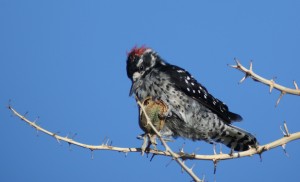 Oak Titmouse and California Towhee. Wild Turkey were successfully re-introduced here in the 90’s and many could be seen roaming in groups through the grassland areas.
Oak Titmouse and California Towhee. Wild Turkey were successfully re-introduced here in the 90’s and many could be seen roaming in groups through the grassland areas.
We used some of our Disney time share points to stay for two days at Disneyland. On the way there, we made stops to find both the Wrentit and the Tricolored Blackbird. The Tricolored Blackbird proved much harder to find than we expected due to the drought conditions which caused most of its typical marshy habitat to dry up. Our two days at Disney was planned as a no birding time, but we just couldn’t help ourselves. Their flower gardens were abuzz and we were able to add the Allen’s Hummingbird.
We left Disney for a day in Los Angeles trying to pick up some of the exotic species. Chuck was only willing to do this on a Sunday since congestion would be minimal. Even so, the driving was miserable as we were constantly jumping back and forth between freeways and highways and city streets. We drove to pocket neighborhoods, city parks and nature preserves. We added California Gnatcatcher, Ridgeway Rail (a localized bird which has been split off from the Clapper Rail), Northern Red Bishop, Indian Peafowl (Peacock), Red-whiskered Bulbul,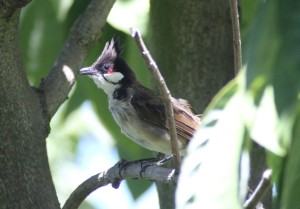 and the Yellow-chevroned Parakeet. The Scaly-Breasted Munia were reported all over the area, but we couldn’t find any. In the beautiful LA Arboretum, we enjoyed walks through the trees, flowers and sculpture, but only added yard ideas in case I ever decide to settle down and pull our landscaping together. In October, we have a field trip scheduled as part of a birding festival where their tour van drives a group around in search of Miami specialties- I feel certain this will be a much preferable way to pick up a few extra exotics.
and the Yellow-chevroned Parakeet. The Scaly-Breasted Munia were reported all over the area, but we couldn’t find any. In the beautiful LA Arboretum, we enjoyed walks through the trees, flowers and sculpture, but only added yard ideas in case I ever decide to settle down and pull our landscaping together. In October, we have a field trip scheduled as part of a birding festival where their tour van drives a group around in search of Miami specialties- I feel certain this will be a much preferable way to pick up a few extra exotics.
Next stop was Ritzy Malibu Beach. One would think that the Malibu area campgrounds, especially at the ridiculous prices (the highest we have paid to date-public or private), would be nice. Instead they were barely decent. Dirty bathrooms and trashy park grounds, poorly working pay showers, lousy water, and no electricity sites. Seems a shame, but it explains why so few people were camping here. It was in this area that we discovered how beautiful the velvety gray Heerman’s Gull is, 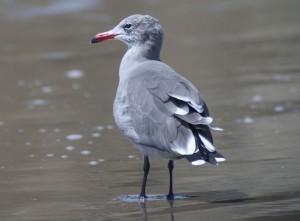 and how elegant the Elegant Tern looks with its rosy breast in spite of his punky hair-do.
and how elegant the Elegant Tern looks with its rosy breast in spite of his punky hair-do. 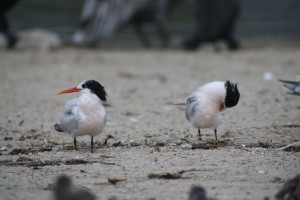 It was also this area that we finally found our first Black Turnstone
It was also this area that we finally found our first Black Turnstone 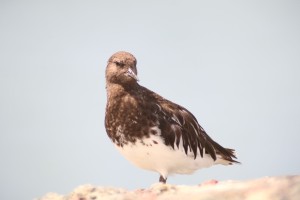 and Surfbird; we had unsuccessfully looked for these two throughout Alaska.
and Surfbird; we had unsuccessfully looked for these two throughout Alaska.
Our Santa Cruz Island trip was really designed as a day trip out to the island, but the 1.5 hour ride each way gave us an opportunity to see two new pelagic birds, the Black-vented and the Pink-footed Shearwaters. I am always amazed that with our limited experience with pelagic birds that we can learn to tell the difference since they seem to soar by so quickly as opposed to sitting patiently on a branch for study. The main purpose of this trip was actually to see the Island Scrub Jay since this is the only place in the world to find one (it differs from the Florida and Western Scrub Jays). 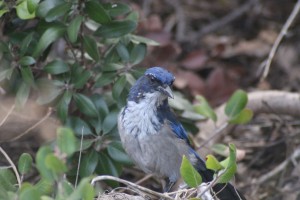 And as you can see by the picture we did! The Island naturalist explained that isolation of species in areas like this island, which is three times the size of Manhattan and houses over 60 endemic species, causes gigantism and dwarfism for species survival which allowed this Jay to evolve 30% larger than other Jay species, and forced this cute Island Fox to evolve smaller.
And as you can see by the picture we did! The Island naturalist explained that isolation of species in areas like this island, which is three times the size of Manhattan and houses over 60 endemic species, causes gigantism and dwarfism for species survival which allowed this Jay to evolve 30% larger than other Jay species, and forced this cute Island Fox to evolve smaller.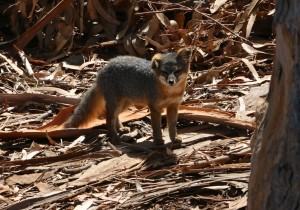
After claiming that we left nothing in Los Angeles to ever come back for, we were forced to do so. We left Malibu headed up to the Angeles National Forest, however after several hours of driving the winding mountain roads, our check engine light came on. Not willing to take chances with mountain driving we headed back down to the closest Mercedes shop. They checked the error codes, referred us to the closest dealer, who had to refer us to the closest dealer who worked on Sprinters, who told us that the codes had been erased by the first shop! Hours of waiting rooms and driving around in the Los Angeles area meant that we were really appreciative of the mountains once we got back up to them. In the Angeles Mountains, among the many other birds here, we were able to see both Lesser and Laurence’s Gold Finch, and both the California and Mountain Quail; two pair of species that we could enjoy seeing nearly side-by-side to allow us to contrast and compare them.
For Labor Day Weekend we were registered at a campground on the Kern River in the Sequoia National Forest. Campers packed the campground and riverbanks partying until late into the night. Driving in the forest twisted us through the mountains up and down from 3,000 up to 9,000 feet. At the Trail of 100 Giants we learned to differentiate between the Giant Sequoia (ok, that was easy), the Sugar Pine, the White Fir, the Ponderosa Pine, and the Incense Cedar. We also learned that Sequoia is the only word that contains all five vowels- I’ve got to remember that one for scrabble especially since it has a “q” in it too! Because we were one of the first groups on the Giants trail that morning, we found it quite birdy with warblers, nuthatches, creepers, jays, juncos, flickers, and a white headed woodpecker. 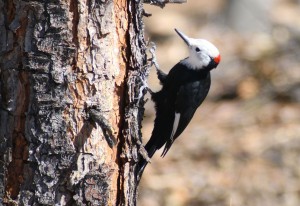 Nothing new for us here bird-wise, but the trees were impressive and the trail was pleasant.
Nothing new for us here bird-wise, but the trees were impressive and the trail was pleasant.
Since we found no new species in the Sequoia area, we are hopeful that we come up with more in phase II of California, which will start with a bona fide pelagic trip on a Debi Shearwater Journeys boat, led by the world renowned Debi Shearwater herself. Hopefully Chuck will enjoy the trip without getting seasick!
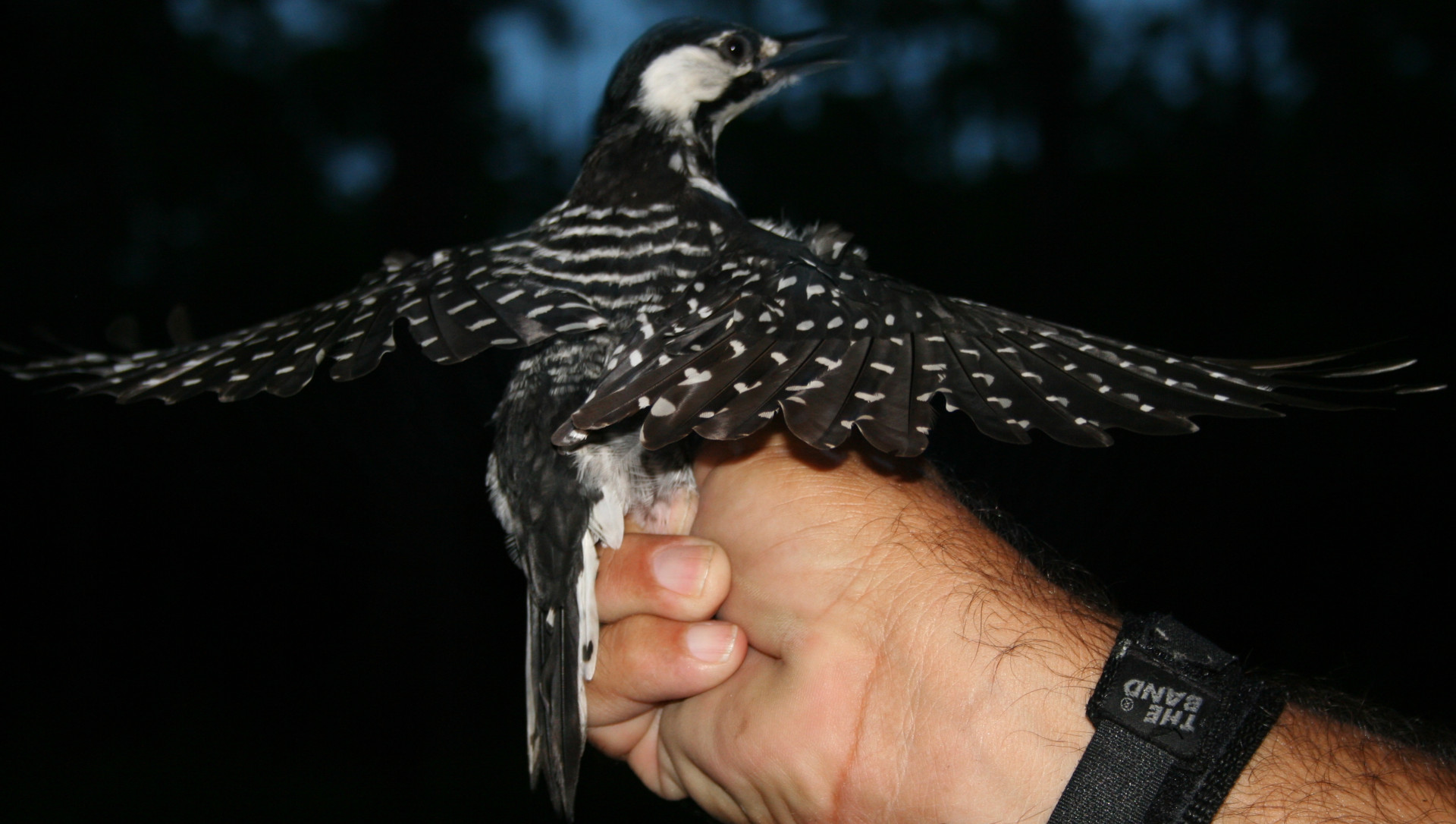
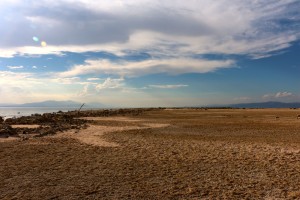
Thanks, both of you, for another installment of informative narrative and spectacular photos… what fun! We’re looking forward to your next posting… 🙂 Christie and Tom